If you’ve been googling electric bike UK law (or variations like uk electric bike law, electric bike law uk, or 500w electric bike uk law), you’ll see lots of conflicting takes. This guide trims the noise into one accurate, easy-to-follow reference, so you can choose a kit, ride legally, and enjoy the road with confidence.
We’ll cover what counts as an e-bike in Great Britain (the EAPC rules), where you can ride, how throttles fit into the picture, what happened with the 2024–25 500 W consultation, and a practical checklist before you buy. When you’re ready to build or upgrade.
The legal baseline: what counts as an e-bike (EAPC) in Great Britain
-
Have pedals you can use to propel it;
-
Use a motor with maximum continuous rated power of 250 W;
-
Cut off assistance at 15.5 mph (25 km/h);
-
Be ridden by someone aged 14+.
If you meet those conditions, you don’t need registration, tax or insurance, and you can ride where pedal cycles are allowed. The GOV.UK rule page and the official EAPC info sheet both confirm these points.
-
Labels & markings. The EAPC info sheet also explains the marking expectations (manufacturer, power, and either voltage or max assisted speed) on the bike. It’s a small detail that helps show your build is within spec.
-
Northern Ireland note. NI now aligns with EAPC treatment too (the older requirement for moped-style licensing was removed). Check nidirect for local wording if you live there.
Where you can ride (and where you can’t)
If your bike qualifies as an EAPC, you can ride on the road and use cycle lanes and paths like any normal bicycle. Pavements (footways) are not permitted for cycling unless clearly signed/shared. This remains the simple, durable rule across national guidance and cycling bodies.
Throttles explained—what’s legal and what needs type approval:

-
Walk-assist throttles up to 6 km/h (3.73 mph) are fine without type approval.
-
A “twist-and-go” throttle that can propel the bike over 6 km/h without pedalling needs type approval to be used on public roads as an EAPC. That’s set by assimilated EU Regulation 168/2013 and reiterated in the consultation documents.
What happened to the “500 W” idea?
-
Increasing the EAPC motor’s maximum continuous rated power from 250 W to 500 W; and
-
Allowing full-throttle operation up to 15.5 mph without type approval.
Outcome (January 2025): The government decided not to take these proposals forward. The EAPC rules remain unchanged at 250 W/15.5 mph and the throttle position (type approval above 6 km/h) still stands. Multiple reputable summaries reported the decision at the time.
So if you’re reading about “new UK 500 W e-bike law,” that’s not in force. Stick with the existing 250 W/15.5 mph framework for public roads.
How UK e-bike law affects buying a kit (advantages & drawbacks)

Advantages of staying EAPC-compliant (pros)
-
No registration/tax/insurance required—treated as a bicycle.
-
Access to cycle lanes/paths and everyday infrastructure.
-
Lower total cost of ownership vs. motor-vehicle classification.
-
Simple enforcement story if you’re ever asked—your kit meets the clear EAPC criteria.
Drawbacks of staying within 250 W (cons)
-
Less peak punch on steep climbs compared to high-power off-road kits.
-
Strict 15.5 mph assist cut-off can feel limiting on open roads or windy days
-
Throttle use is limited to walk-assist unless type-approved.
Who benefits most from EAPC builds?
Urban commuters, family riders, and anyone who wants to blend into normal cycle traffic with minimal admin. If that’s you, a well-specced 250 W kit with a sensibly sized battery is the sweet spot.
Off-road/high-power kits: where they fit (and where they don’t)
High-power hub or mid-drive systems (e.g., 500 W, 750 W, 1000 W+; 52/60/72 V batteries) offer thrilling acceleration and sustained speed—but they’re not EAPCs for UK public roads. On public highways, they’re treated like motor vehicles unless the manufacturer has secured type approval for the configuration (rare for DIY kits).
Keep these builds to private land, trail centers that permit them, or jurisdictions with different rules. For general UK road use, it’s simpler to maintain a separate, compliant bike (or a compliant mode you actually use) and reserve the high-power machine for appropriate venues. The GOV.UK guidance is plain on the 250 W/15.5 mph limits.
Compliance checklist before you buy (features & setup points)

Core features to check
-
Motor rating: The continuous rating must be ≤ 250 W (don’t rely on marketing “peak” numbers).
-
Assisted speed: Controller/display must cut assistance at 15.5 mph.
-
Pedal assist (PAS): Assistance should require pedalling; configure throttle as walk-assist ≤ 6 km/h unless type-approved.
-
Markings: Ensure the bike displays manufacturer, power, and voltage or max assisted speed.
Install & safety points
-
Brakes & tyres: Added weight and torque demand reliable rotors/pads and appropriate tyres.
-
Torque arms & fasteners: Re-torque axle nuts and inspect torque arms after the first 50–100 km.
-
Wiring & connectors: Use quality connectors; secure cables to avoid chafing.
-
Lighting & reflectors: Follow standard pedal-cycle lighting rules at night. (EAPC still follows cycle lighting norms.)
Buyer’s guide: choosing a compliant kit that still feels great

Motor & drive style
-
Front hub (250 W): Easiest install, great for flat commutes and folders. The front-end weight change is mild at this power.
-
Rear hub (250 W): Better traction feel, simple wiring. Popular for city and mixed riding.
-
Mid-drive (250 W): Most “natural” feel; climbs efficiently by using your gears. Installation is more involved but pays off on hills.
Battery & range
-
Urban riders often do brilliantly with 360–500 Wh packs. Stop-start city speeds and 25 km/h caps make energy use modest.
-
Hilly or longer routes benefit from 500–700 Wh.
-
Consider charger amperage (2–5 A) and whether a café top-up fits your day.
Controller & display
-
Configure assist cut-off at 25 km/h and keep throttle at walk-assist.
-
Use smoother PAS ramps; gentle engagement makes shared paths friendlier.
Mounting & anti-theft
-
Triangle or down-tube mounts keep weight centered.
-
Quick-remove batteries make café stops more relaxed—pop the pack off like a laptop.
Risks of non-compliance (and how to avoid them)

Enforcement & seizure. If you’re stopped on the road and your bike is clearly over-spec (e.g., 500 W+ with open throttle-only operation), you risk being treated like a motor vehicle rider—no insurance, no registration, no licence—which can be a costly conversation.
Insurance gaps. Even if you carry specialist cycle insurance, policies can exclude non-compliant machines. Staying within EAPC limits avoids awkward claim disputes.
Safety trade-offs. Big power without the right brakes, tyres, and torque control is a recipe for mishaps. If you do build a separate high-power off-road bike, spec the stopping to match the going.
How to avoid problems: Keep one bike defiantly EAPC-compliant for public roads and cycle lanes—and keep any high-power machine for appropriate venues. It’s the stress-free way to enjoy both worlds.
Quick “features vs. law” matrix (practical pointers)
-
Feature: Pedal-assist with temperature-stable cut-off → Law: Required to stop assisting at 15.5 mph.
-
Feature: Throttle with walk-assist only → Law: Fine up to 6 km/h without type approval.
-
Feature: Clear 250 W continuous rating → Law: Meets EAPC power limit.
-
Feature: Bike labeling (manufacturer, power, voltage/max speed) → Law: Recommended marking expectations for compliance clarity.
Simple build recipes (benefits & trade-offs)
A) UK-legal commuter (front hub, 250 W)
-
Benefits: Light, simple, affordable; quick install on hybrids/folders; low maintenance.
-
Trade-offs: Less traction on steep/wet starts vs. rear hub; modest hill punch.
-
Battery tip: 360–500 Wh is plenty for city duty.
B) UK-legal hill-friendly (mid-drive, 250 W)
-
Benefits: Most natural feel, efficient on climbs by using gears; balanced handling.
-
Trade-offs: More involved install; drivetrain care matters; costlier.
-
Battery tip: 500–700 Wh for hilly commutes.
C) Private-land performance (rear hub, 52–72 V, >250 W)
-
Benefits: Big torque and sustained speed for off-road venues.
-
Trade-offs: Not legal as an EAPC on public roads; needs braking and setup discipline.
-
Battery tip: High-capacity triangle packs, strong connectors, controller cooling.
Conclusion:
The headline for electric bike UK law in 2025 is uncomplicated: the EAPC rules still define legal road riding—250 W continuous, assist up to 15.5 mph, pedals, and 14+. Throttles are fine for walk-assist to 6 km/h; anything more needs type approval. The 2024 proposals to raise power to 500 W and allow full-throttle to 15.5 mph were not adopted in January 2025, so nothing changes there.
For most riders, that’s good news: EAPCs keep cycling accessible and fuss-free. Choose a compliant kit, size your battery for your real rides, and enjoy cycle lanes and paths with confidence. If you also love high-power machines, keep a separate, off-road build—and keep your road bike firmly within EAPC specs.
When you’re ready to plan range, chargers, and mounts, you’ll find straightforward options in the Conversion Kits + Battery. Ride safe, ride kind, and let the miles add up.
Frequently Asked Questions
Is a 500 W electric bike legal in the UK?
Not as an EAPC on public roads. The current limit remains 250 W continuous and 15.5 mph assist cut-off. The 2024 proposal to allow 500 W and full-throttle up to 15.5 mph was not adopted (Jan 2025).
Can I have a throttle?
Yes, but only up to 6 km/h without pedalling unless the bike has type approval. Above 6 km/h on throttle-alone, you’re outside the EAPC category.
Do I need a licence, registration or insurance?
No—if your e-bike is an EAPC. If it isn’t (e.g., 500 W+ or throttle-only above 6 km/h without type approval), it’s classed as a motor vehicle for the road and would trigger those requirements.
Where can I ride my e-bike?
Anywhere pedal cycles are permitted—roads and cycle lanes/paths. Not pavements unless signed/shared.
What if my kit has a “legal mode” button?
If the continuous rating is above 250 W or the bike can be propelled past 15.5 mph under power, “legal mode” claims don’t change the classification. For public roads, the build must actually meet EAPC limits.
Does Northern Ireland follow the same rules now?
Yes—EAPC treatment applies; check nidirect for local wording and any path specifics




























